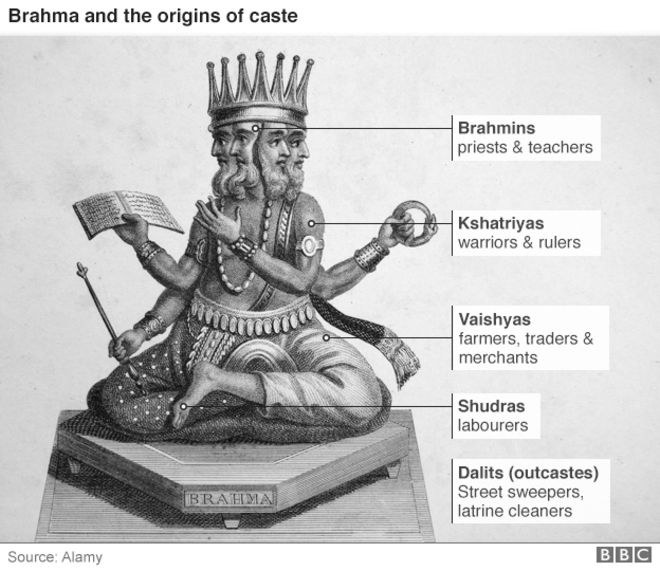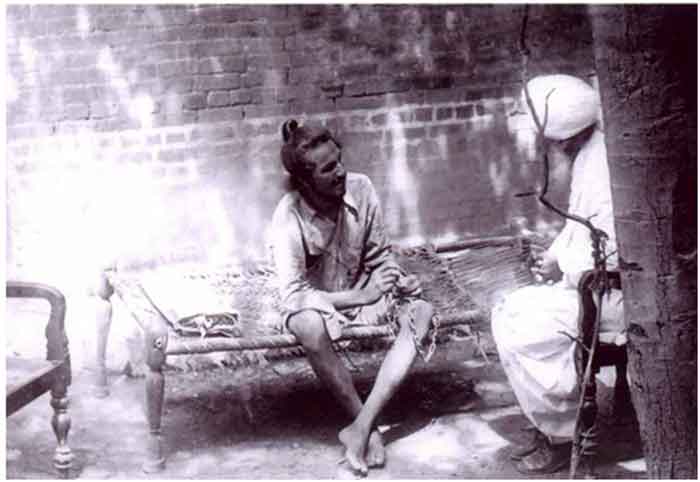
Adi Shankaracharya, reflecting on the sublime mysteries of non-dualism, the undifferentiated reality and the irrevocable principle of oneness governing all existence, emerged from the waters after performing his daily ablutions in the holy Ganges at the ancient city of Varanasi. Suddenly, a disheveled outcast, the peddler in pollution, the dark and abominable Chandala appeared with his four big dogs like a messenger from the heart of cosmic consciousness. True to the predeterminism of communitarian thoughts permeating human lives that subsumes all principles, logic and rationality, the great sage screamed “Get off my way, you accursed”.
The Chandala, relegated this insult, only as a fleeting shadow, the undeserved curse as the momentary sound of flapping wings in the vastness of space and immensity of time, calmly responded, “Were these words addressed to my body or to my soul? Is there any difference to our bodies, both nourished and sustained by food? Is there any differentiation between a Brahmin and a Chandala, the pure and the pariah for the Supreme Soul, who is the source of life pervading all beings, and is the doctrine you zealously profess? And continued “Some ascetics wear saffron robes and carry the stick of enlightenment and wooden pots in their hands, and speak eloquently, yet without an iota of knowledge and wisdom, deceive people by their external appearance”. The incorrigible and steadfast priestly class, the authors of scriptures ascribed the event as a testing of Lord Shiva, disguised as a Chandala, thus consoling their bruised egos that such perennial pearls of wisdom could never have been uttered from the unholy tongue of a loathsome untouchable.
The Indian subcontinent is an admixture of different races; The Aryans, Dravidians, Mongolians and Scythians, who had immigrated with their indigenous cultures millennia ago. They fought with their predecessors for cultural dominance, before settling down to co-exit peacefully. Though ethnically heterogenous in composition, these tribal and pastoral races, through forces of socio-cultural intercourse and constant interactive evolution have created a unique homogenous cultural identity, that even to this day had withstood the tests of time. This cultural homogeneity unprecedented in the history of human civilizations also pose serious challenges in explaining the genesis of divisive caste systems within the gamut of this inclusiveness and identity in the Indian peninsula.
According to Dr. Ketkar, the eminent sociologist and historian, caste is defined as “a social group having two characteristics: (a) membership is confined to those who are born of members and includes all persons so born; (b) the members are forbidden by an inexorable social law to marry outside the group.” Thus, Prohibition of Intermarriage and Membership by Birth are the two primary characteristics of caste which when interpreted correctly in a historical perspective narrows down to one guiding principle- the absence of inter marriage or Endogamy.
According to a paper presented at the Columbia University, on the origin, mechanism, and development of castes in India, Dr. B.R. Ambedkar confirms that the practice of Endogamy was alien to Indian societies. And like other ancient civilizations, if there is one custom that has survived its primeval forms from the days of the ancient tribal codes, it’s the custom of exogamy. It still savors its pristine vigor and as a positive injunction is prevalent throughout India as the law of matrimony, which prohibits not only marriage within immediate blood-kin (Sapindas), but also between the same class (Sagotras). In such a socio-historical context when exogamy was the creed for matrimony and any infringement to it was considered a sacrilege, how the custom of endogamy gained prominence and became the dominant social order require a careful analysis of the malicious intents of its messiahs.
The social center of gravity has always been centered on class than an atomistic view of the individual. Though the society is composed of individuals, they always identified with a certain social class, whether intellectual, economic or social. Many revolutions have buffeted history to close the huge chasms of class distinctions that have discriminately alienated a majority of the population from a decent standard and quality of life; the rise of Communism being a classic case. Therefore, at an unfortunate and momentous point in Indian history, a group, probably pertaining to a prominent class decided to form themselves into a closed system of caste, through the strategic prohibition of inter-marriage. A caste essentially is an enclosed class.
The success and sustenance of endogamy is inevitably dependent on maintaining the numerical equality of both sexes of marriageable units. But this represents insurmountable challenges since its effective practice is intertwined with married couple dying simultaneously. Left to nature, this created surplus man and woman within the endogamous enclosure and the high priests must devise solutions to dispose of this surplus menace to guarantee its preservation. Dr. B.R. Ambedkar’s critique further expounds that the methods ingeniously devised and eulogized for their summary execution were (a) burning the widow on the funeral pyre of her husband (b)forced widowhood on the woman, less gruesome but still ruthless (c) enforced celibacy on the man (d) girl marriage.
The rigorous observance of the above customs and the universality of its prevalence was obtainable in one caste in India, namely the Brahmins who occupy the pinnacle in social hierarchical order. If all other customs of other castes in the system of castes are derivative of the Brahmanical practices, then it’s obvious which social class can be rightly defined as the originators of the institution of caste.
It’s wrong to assume that the ancient lawgiver, to redeem its sinning humanity, Manu who is indubitably regarded as the father of caste doctrines, had codified its sinister structures for his wicked ulterior motives or realpolitik interests. How would a cunning individual, by the stroke of his pen, condemn a majority of the population to become subservient of its masters and revile another section as wild brute’s denying the right to existence? How could this be accomplished without any resistance or violence from the majority, innately aggressive and physically superior population. Also, many orthodox and fundamentalists Hindus have propositioned caste as divinely sanctioned, citing references to its origins from the Dharma-Shastras, and therefore invincible and inviolable in its scope and purpose. Ascribing divinity to any illegitimate, immoral and inhuman traditions is a tested formula for subjugating a gullible public! A logical inference would be that castes existed before Manu and he could have only philosophized it and codified its loosely defined ethics and moral codes.
Western scholars and historians, prejudiced about skin color have offered a different narrative of the origins of caste, primarily based on the theory of Varnas, classifying people based on occupation. Other possible delineations elucidated are (a) the rise of new beliefs (b) cross-breeding, (c) survival of tribes and (d) migration. But it should be noted that these classifications and groupings were prevalent in most ancient societies and they have never circumscribed themselves within a self-centered cocoon of castes.
The propagation and growth of castes in India, was probably because of two compelling reasons then, namely (a) the laws of imitation and (b) ex-communication. The priestly class were regarded as the crème-de-la-crème in most ancient societies, the medium of propitiating the pagan gods and the foundational basis of its faith and morals. Mankind has a natural propensity to imitate that has belief as its central agent and its causes remain obscure in our nature. Routine interactions and prestige of the source of imitation is a driving force for emulation by others.
A Brahmin was considered as the perfection of creation, refined in the karmic process of cycles of life and death, as enshrined in the ridiculous theory of rebirth, a demi-god, the epitome of all-pervading goodness, nearest to the attainment of salvation, and venerated by the scriptures. Therefore, the primary reason for other classes to become self-enclosed into castes and imitate the endogamous traditions and creed for its self-preservation was because the Brahmin did it!! And in that process, many closed their doors for others, and others found it closed against them, setting in motion the wagon-wheel of ex-communication. The social stratification, hitherto became a closed system unlike the ancient Indian and other world societies where social mobility was possible due to open social stratification.
By creating the Brahmin caste, they created the non-Brahmin castes and similar enclosures have resulted in a bewildering multiplicity of castes in the Indian peninsula at some pitiful moment in her history. Imitation led to cascading ex-communication of social classes who were forced to create castes and has eventually caused a labyrinthine mess of complexed social fabric, and its deleterious effects on the Indian society is felt even to this day. A collective prejudice against the working class, the manual laborer who produces through his sweat, blood and toil, rendering him inferior in the social hierarchy of labor is a psychological bondage the Indian society is burdened with, and is a consequence of the stratification of caste system! Social inequalities, always have an economic price to pay.
Imitators always floundered on the cross-roads of time and became prisoners of their affinities and enchained in the mercy of someone’s thoughts, perceptions and deeds. The world we inhabit now was largely built by brave men whose original, lofty, revolutionary, inventive and innovative thoughts liberated humanity from the regressive, conservative and slavery of rotten, inhuman dogmas, customs and practices. When mankind regained the infinite power of his rational mind and exercised his critical faculties, the citadels of ignorance crumbled and science was born…
Somewhere in time, in the post-industrial knowledge society of the 21st century, a progressive and a conservative dressed in designer suit, went for a walk by the sea, in the splendor of twilight. Like a primordial voyager, suddenly the Chandala appeared with his four big dogs, and relieved in not seeing a Shankaracharya, greeted them and asked, “Have you finally been enlightened by the truth of caste?” To which the liberal progressive replied, “Homo Sapiens” and the conservative averred, “We were born from the head of Brahma”.
The Chandala smiled wryly and when deep dusk descended over the place, spoke with the parting words, “Remember that the body resides in the soul and not the soul in the body”, and walked away into the darkness, whispering under his breath, immortalizing Sartre, “Man is a useless passion.”
Jayakhosh Chidambaran is a management consultant and researcher.
















































